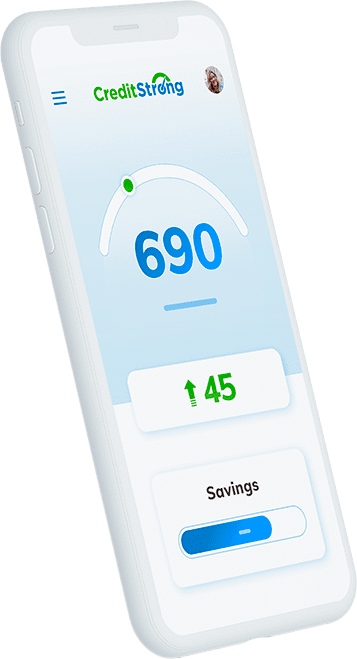The 20 Most Relevant Credit Score Statistics in 2023

Build strong credit
while you save
If you’re looking to learn more about credit scores, what a FICO score is (as well as bureaus like Equifax, Experian, and TransUnion), and how you measure up to other Americans, let’s dive into this exhaustive list of credit score statistics that you should know.
Number of Americans With No Credit History
According to the Consumer Financial Protection Bureau (CFPB), approximately 26 million adults (one out of 10) are considered to be “credit invisible”, meaning they have no credit history as they’re without credit cards, loans, and other lines of credit.1
Of course, if you have a credit card, that doesn’t necessarily mean you will have a credit score. Around 19 million adults lack a score altogether due to credit reports with minimal credit usage or out-of-date credit history. Now’s the time to open a credit card or loan to build your history.
The Average Credit Score by Cohort
What Is the Average Credit Score?
Data provided by Experian revealed that the average FICO credit score (scores maintained by the credit bureaus, Equifax, Experian, and TransUnion) for Americans was 716 in 20212.
According to Experian, this average FICO score may be a result of credit scoring factors such as fewer late payments or delinquencies on credit cards, shrinking debt (credit card debt, loan debt, etc.), and a decrease in credit utilization.
There are other credit scoring models such as VantageScore, but the majority of lending decisions are made using FICO scores, so this review is focused only on FICO scores.
What is the Average Credit Score by Age Group?
The average credit score across various age groups in the U.S. reveals an upwards trend in the average credit score, with each age group experiencing a minor credit score increase in comparison to average credit scores reported in 2019.3
Here is the following average score breakdown by age group:
- Ages 18-23: 674
- Ages 24-39: 680
- Ages 40-55: 699
- Ages 56-74: 736
- Ages 75+: 758
What Is the Average Credit Score By Generation?
The above credit score statistics translated into generations rather than age groups provide us with the same average scores. These average scores by generation include the following:
- Generation Z: 674
- Millennials: 680
- Generation X: 699
- Baby Boomers: 736
- Silent Generation: 758
Average Credit Score By Income
According to American Express, the average credit score by income are as follows4:
- $30,000 or less per year: 590
- $30,001 to $49,999: 643
- $50,000 to $74,999: 737
The correlation between lower average credit scores and lower-income may be associated with factors like higher-income individuals being able to pay back credit card debts (with lower interest rates) more easily as well as being able to maintain a lower credit utilization ratio.
Those with higher income may also have higher credit limits in comparison to those with lower income.
That being said, income is not the most accurate measurement of scores. Income is only one factor that plays a role in your score. You can still have a low income and have good credit. If you fall into a lower income bracket, don’t worry. Your income doesn’t determine your score.
Percent of Credit Files that Don’t Qualify for a FICO Score
The Ascent (a publication operated by The Motley Fool) reports that data released in 2019 found 11 percent of Americans don’t qualify for a FICO credit score5.
In order to qualify for a FICO score, you must have:
- At least one credit account (credit card, loan, etc.) that has been open for at least six months (the length of credit history will impact your score)
- At least one account that has reported to credit bureaus within the past six months
- No deceased status on your account6
If you share a credit card or other types of credit with someone who has passed, this may account for the deceased status that’s preventing you from receiving a FICO score on your credit report. Watch your credit with a credit reporting agency like Experian to report this.
Percent of Americans Who Have a Credit Score of 800 or Higher
Another report from The Ascent reveals that only 22 percent of Americans have a credit score of 800 or greater7.
Those who have a credit score of 800 to 850 are considered to have exceptional credit, and it appears that older individuals as well as those with incomes ranging from $101,000 to $150,000 have much higher credit scores within the perfect range.
The Average FICO Score Increase in the Last Decade
Between 2010 and 2020, the average FICO score has increased by approximately 24 points. The average FICO score in 2010 was 687, while today’s average FICO score in the United States is 711.
This trend increase in credit score statistics also seems to appear in different age brackets, as illustrated in the data above in Experian’s and The Ascent’s reports.
Percent of Adults Who Never Check Their Scores
One study conducted by Javelin Strategy & Research and sponsored by TransUnion revealed that 54 percent of adults never check their credit scores8.
Checking your credit score is a crucial aspect of reaching your financial goals and correcting any mistakes in your credit report.
Whether you regularly use a credit card or are paying back loans like student loans, always check your score on a regular basis, whether it’s through a third-party application or using an established credit reporting company like Experian.
Percent of Adults Who Check Their Score Monthly
Data regarding how many adults check or don’t check their scores will vary from study to study due to the nature of the sample population. Research offered by CreditCardInsider.com found that only 21 percent of their respondents check their credit score on a monthly basis9.
This low number can be supported by data in other studies, such as a LendingTree survey that found only 33 percent of adults checked their score within the past year in 202010.
What is the Highest Credit Score?
The highest possible credit score that you can receive is 850. FICO scores range anywhere from 300 to 850.
What is Considered as a Perfect Credit Score?
If you manage to reach a score of 850, you have obtained the perfect credit score as this is as high of a score that you can reach when you grow your FICO score. That being said, an exceptional credit score falls anywhere between 800 and 850, which is close to perfect.
What is Considered as a Poor Credit Score?
According to Capital One, a FICO score that falls below 580 is considered to be a poor credit score. Lower credit scores can make it difficult to get approved for credit cards or loans as approximately 61 percent of those with low credit scores fall behind on their loans11.
Come up with a credit card debt or loan repayment plan (for default loans like student loans) to reduce debt and credit utilization, look for accounts that build credit, and find other ways like Experian Boost to improve your score if you have negative items contributing to your bad credit.
Experian also offers free credit score checks to help you stay on top of your score and payment history. Your credit card balance doesn’t have to stop you from moving forward financially.
What is Considered as a Good Credit Score?
Equifax reports that scores between 670 and 739 are considered to be good credit scores. Meanwhile, scores ranging from 580 to 669 are considered to be fair12.
Percent of the U.S. Population that has a FICO Score Below 550
Fortunately, a low percentage of the U.S. population appears to have low FICO scores. Data released by FICO in 2019 reveals that only 11.1 percent of the U.S. population has a FICO score ranging between 300 and 54913.
It also reveals a downward trend, indicating that the average FICO score is on the rise and the average credit card debt and other debts are on the decline for Americans.
What Percentage of the Population Has a Credit Score Over 700?
The same data referenced above also reveals the percentage of the population with a score of over 700. According to FICO.com, approximately 59.2 percent of the U.S. population has a credit score range between 700 to 850.
Which City/State has the Highest FICO Score?
The Ascent (which we referenced in the section, % of Americans Who Have a Credit Score of 800 or Higher) reports that the State with the highest FICO score is Minnesota, which has an average FICO score of 739, the highest average credit score in the U.S.
Which City/State has the Lowest FICO Score?
Meanwhile, data from the resource above lists Mississippi as having the lowest average credit score among its residents, with the average FICO score being 675. This score is still considered to be a good credit score, which is a positive indicator of overall credit health in the U.S.
The Credit Score Needed to Buy a House
Your FICO score plays a major role in your ability to secure a mortgage. The type of mortgage that you’re looking to secure will determine what your score should be. According to QuickenLoans, these are the following credit scores you need to work with lenders14:
- Conventional Mortgage: 620
- VA Loan: 580
- FHA Loan With 3.5 Percent Down: 580
- FHA Loan With 10 Percent Down: 500
If you fall below these guidelines, ask yourself, how long does it take to build credit? Then, come up with a plan of action to help you work towards your goal.
The Credit Score Needed to Buy a Car
According to Investopedia, the average credit score you will need to purchase a car is 661 and above15.
You may be able to find financing options with a bad credit score, but you will generally need a cosigner or more money to put down towards your car loan when you have bad credit since you are a nonprime or subprime borrower.
You should also consider the role insurance scores play in your car buying journey as credit scores help insurance companies assess risk when you apply for insurance. Make sure your credit score is correct with Experian or other bureaus before you apply for insurance.
Footnotes:
3. https://www.cnbc.com/select/average-credit-score-by-generation/
4. https://www.americanexpress.com/en-us/credit-cards/credit-intel/credit-score-by-age-state/
6. https://www.myfico.com/credit-education/faq/scores/fico-score-requirements
7.https://www.fool.com/the-ascent/research/average-credit-score/
10. https://www.lendingtree.com/credit-cards/study/americans-check-credit-reports/
11. https://www.capitalone.com/learn-grow/money-management/what-is-a-bad-credit-score/
13. https://www.fico.com/blogs/average-us-fico-score-ticks-706
14. https://www.quickenloans.com/learn/credit-score-to-buy-a-house
15. https://www.investopedia.com/what-credit-score-do-you-need-to-buy-a-car-5181034
CreditStrong helps improve your credit and can positively impact the factors that determine 90% of your FICO score.
